As my brother Herman described in his post 2097 about the monastery of Agiou Paulou, the monastery was already mentioned in the Typicon of 1046. That makes the monastery one of the oldest monasteries on the Holy Mountain. But why does it look so relatively new with its concrete walls and iron constructions? And is there anything left of the old parts of the monastery? Let’s have a closer look at the interior, with the guidance of the Mylonas map below.


This photo shows us the entrance to the monastery and the courtyard. On the first floor is building Z, the abbots quarters according to Mylonas (1980).

When you turn at his spot 180 degrees you will see the katholicon of the monastery. Building the church has a special history: I will not recall the whole history of the monastery, but in old times the monastery was run by Serbs. This text is from the Feigl book “Athos, Vorhölle zum Paradis”
After the Serbs left Agiou Paulou in 1710, a rather barren era started. But Agiou Paulou experienced a powerful expansion under Abbot Anthimos. It began in 1816 with the new building of the Katholicon and the economic buildings. The struggle for freedom in 1821 brought an interruption. The Greek Athos monks devotedly participated in the popular uprising, and the Turks took revenge: they could not accept that Athos, that did not have a bad time under the Ottomans, rose against the High Gate. “Unfaithful”, as they rightfully said.
St. Paul’s monastery was devastated, plundered and abandoned. The monks escaped and only the most precious relics could be brought to safety at Aegina by Johannes Kapodistrias, one of the leaders of the stand. In the mid-1830s, Greeks took over the devastated and abandoned monastery. Under the active leadership of Abbot Sofronios Kallighas, reconstruction activities were started.

On St. George’s Day in 1839 he laid the foundation stone for the new Katholicon, on St. George’s Day 1844 the keystone. But with ‘Agios Georgios’ there was one thing: Abbot Sofronios seemed to prefer to create a “Greek” Agiou Paulou. So he let his notorious contemporary, the monk Simonides, who had already proven himself a counterfeiter at Karyes, to do some questionable restorations,
of which I will tell you later in this blog.
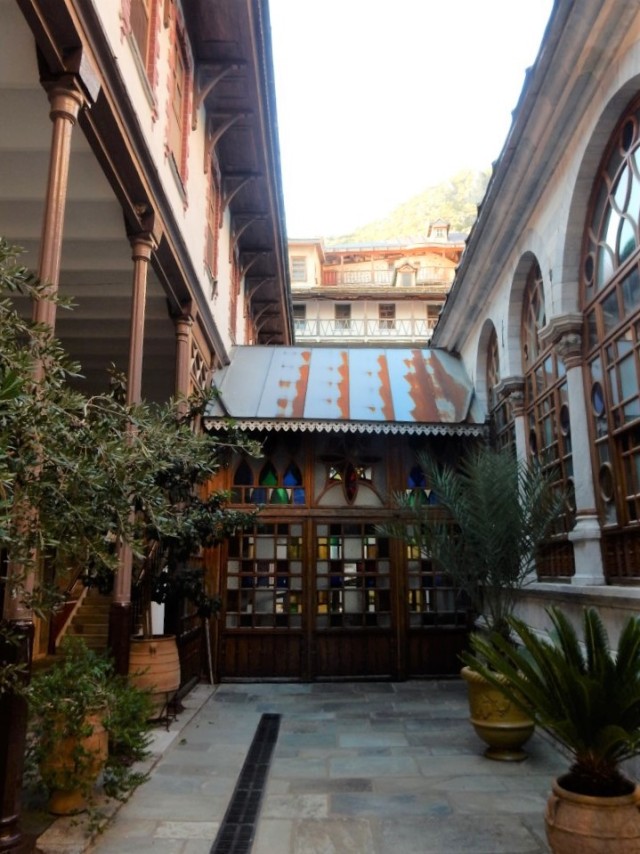
The courtyard with the exo-narthex of the katholicon on the right and building Z2, the guesthouse, on the left. The the covered passage from the trapeza to the church is new, at least, not drawn on the Mylonas plan from 1980.

The passage between the church and the trapeza,

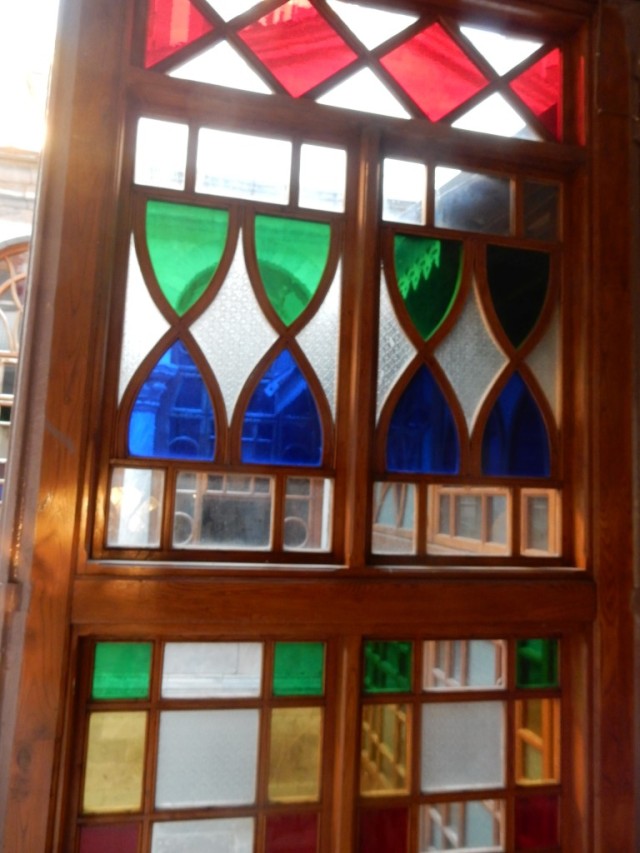
with colored glass.

The other side of the passage, near the stairs to the archondariki – the guesthouse

The North facade of the katholicon, with bell-tower in the background.
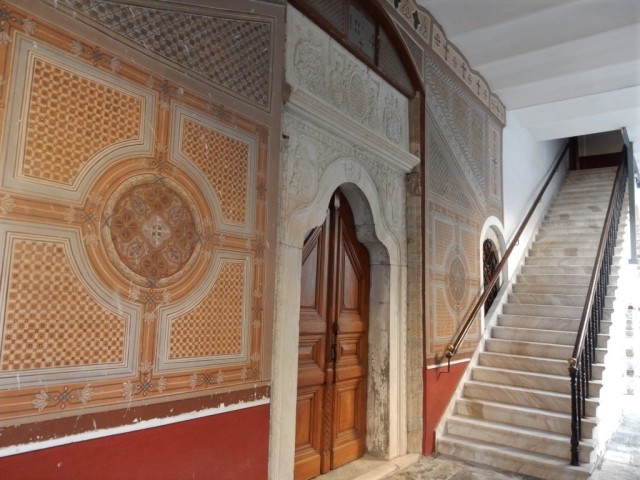
The stairs to the guesthouse and the entrance door to the trapeza, with the year 1894 above it.

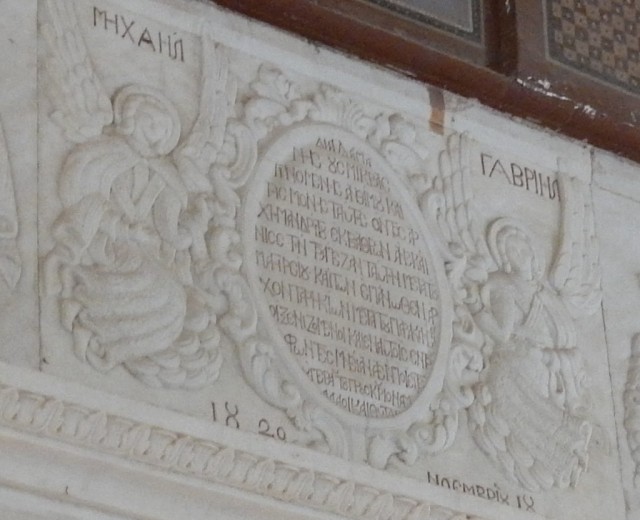
I was lucky to be invited to enter the trapeza and shoot some pictures inside:
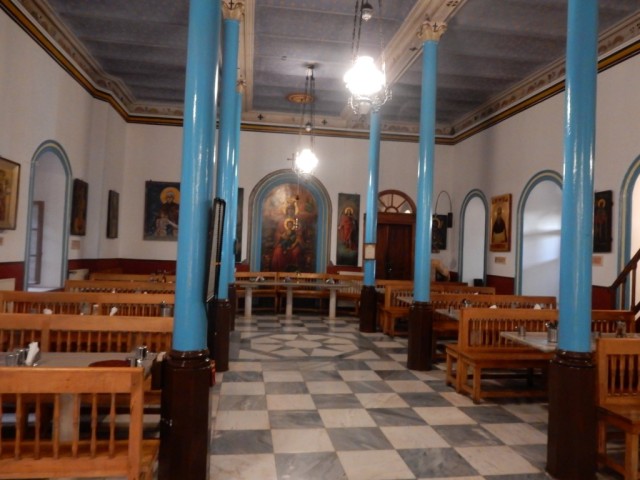
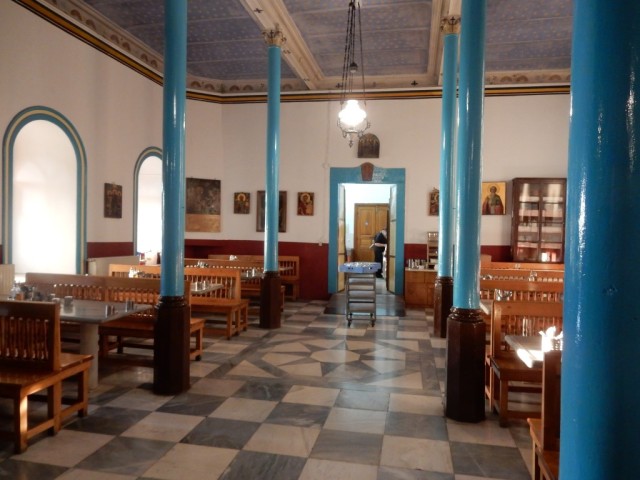

The marble table where the abbot eats his meals. Here is the only wall where murals are placed, showing the Last Supper and the Holy Trinity with the Lord, the Holy Spirit and Jesus Christ with his Cross.
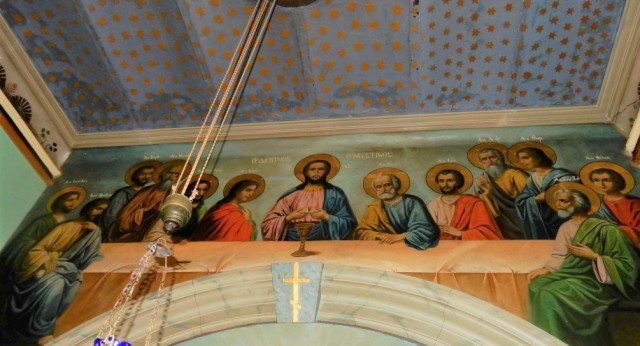
The Last Supper with Jesus Christ and his twelve Apostles. Judas on the left is the only one without a halo.
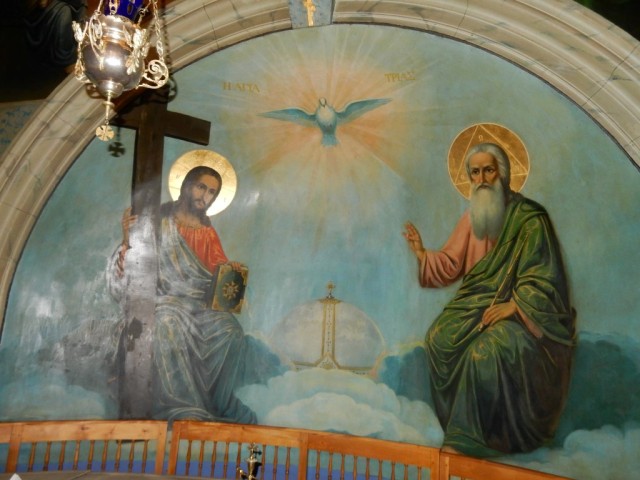
The Holy Trinity.
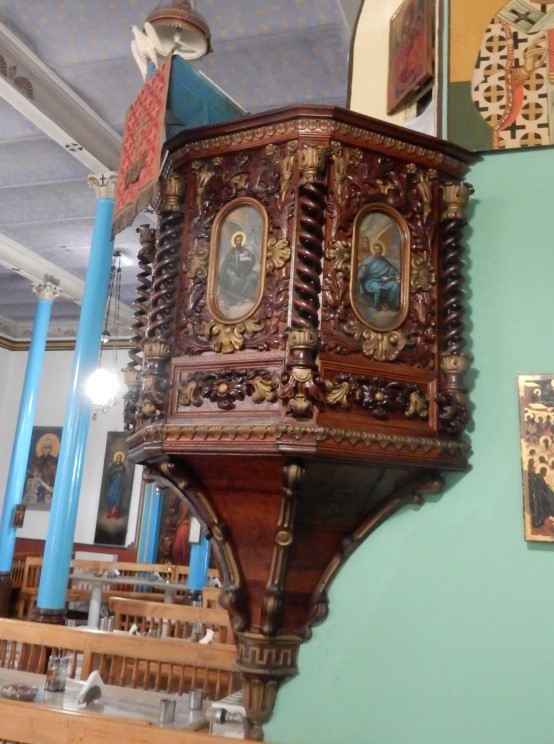

And, on the other side of the trapeza, a painting of the Panaghia with Child.


The doors of the trapeza with the the colored glass passage to the church. Here you’ll see 1835 as year above the door.
I headed my way back outside, in order to find one of the most interesting places in the monastery, the Agios Georgios Chapel. Clearly the monks tried to preserve the few ancient murals that were left in the North wing, as you can see on these pictures:

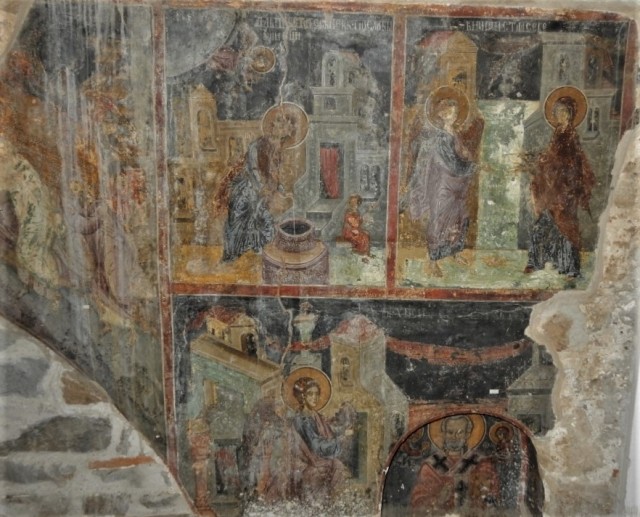
A few remaining murals on the walls in the North Wing. I managed to find the door that leads to the Georgios Chapel, but unfortunately the doors stayed closed to me. There were no monks in the vicinity, so I had to leave without pictures.

The stairs that lead to the Georgios Chapel….
This is what mr Feigl says about this chapel in his book “Athos Vorhölle zum Paradis”:
“As early as 1912, a major fire not only incinerated a large part of Sonofrios’ work, but also irreplaceable works of art from past centuries. And ten years earlier, in 1902, a fire in the library decimated the book collection. But the Georg chapel remained intact.
Today, the Georgian chapel of the Agiou Paulou monastery is widely recognized as a jewel of Athonian sanctuaries, and the artist – Andronikos van Byzanz? – convinces by his masterful achievement and that clearly he does not belongs to any nationality. The dates 1423 and 1425 are legible. The sheltered location high up on the wall, that already borders the mountain, and the Paul’s cave in the wall, saved the chapel from fire and other dangers”.
So the chapel is the oldest part of the monastery and it contains murals of extraordinary quality, that can be compared with the quality of the Protaton murals and the works of Panselinos!
Because I was not able to shoot photographs inside the chapel, I tried to find them in my library about Athos and on the internet. The only pictures I could find where from the Feigl book, where I also found the text about this chapel.
Feigl has this story about monk Simonides, who presumary had already proven himself a counterfeiter at Karyes (what did he do there?), but he also did his “work” in the Georg chapel. The result is a painter’s inscription, overpainted by Simonides, which was to wipe out the memory of Serbian patrons with a few clever brush strokes.

George Chapel, Agiou Paulou. The originally Serbian, later Greek inscription: the apostles John and Andreas on the lower left, Peter and Paul on the right, the Birth on the upper left, Death in the middle and the representation of Mary in the temple on the right.

The War of the Inscriptions: at the time of the Serbian prince Georg Brankovic (1427-1456), who build the mighty tower in Agiou Pavlou and who was called the “Ktitor” – founder – of the monastery, a commemorative inscription in Serbian was placed in the Georgian chapel. At the beginning of the 20th century, the zealot monk Simonides over-brushed the inscription with completely different Greek words, but the original inscription soon reappeared, as is usually the case with historical truths. The result, however, is confusion and almost complete illegibility of the original text.

St. George chapel, revival of Lazarus. The frescoes were created around 1423 by Andronikos from Byzantium.
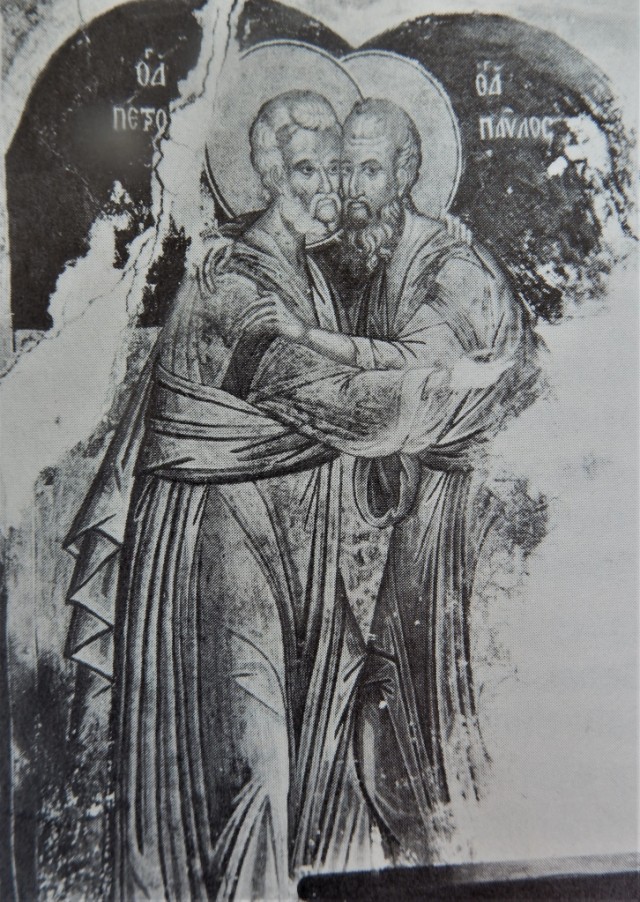
The classic greeting and hug and the brotherly kiss between Peter and Paul – Georgios chapel.

I now know there is an extra reason to go back here (but then I’ll have to see to get inside the chapel!). I hope this moment will be soon…….
Wim Voogd, 8/5/2020

Thanks for this info!
Is there a way to determine what year Simonides did his controversial painting?
Also any connection between forgeries, Karyes and Simonides. Generally the issues relating to forgeries start around 1849, a work called Symais.
Thanks!
Steven Avery
Dutchess County, NY USA
Did you ever find out what Simonides did at Karyes?
Do you know the date (year) that Simonides painted over the Serbian inscription in the Georgian Chapel?
No I don’t have any information about what Simonides did at Karyes.
May I point out a minor mistake?
“At the beginning of the 20th century, the zealot monk Simonides over-brushed the inscription with completely different Greek words, but the original inscription soon reappeared, as is usually the case with historical truths.”
The 20th century is the 1900’s, but it should be 19th century, which is the 1800’s.
Simonides is reported to have faked his own death in Alexandria, Egypt ,1867, but the latest report of his death was 1890. So, the 20th century is not probable.
Thank Edward for your comment and expertise.